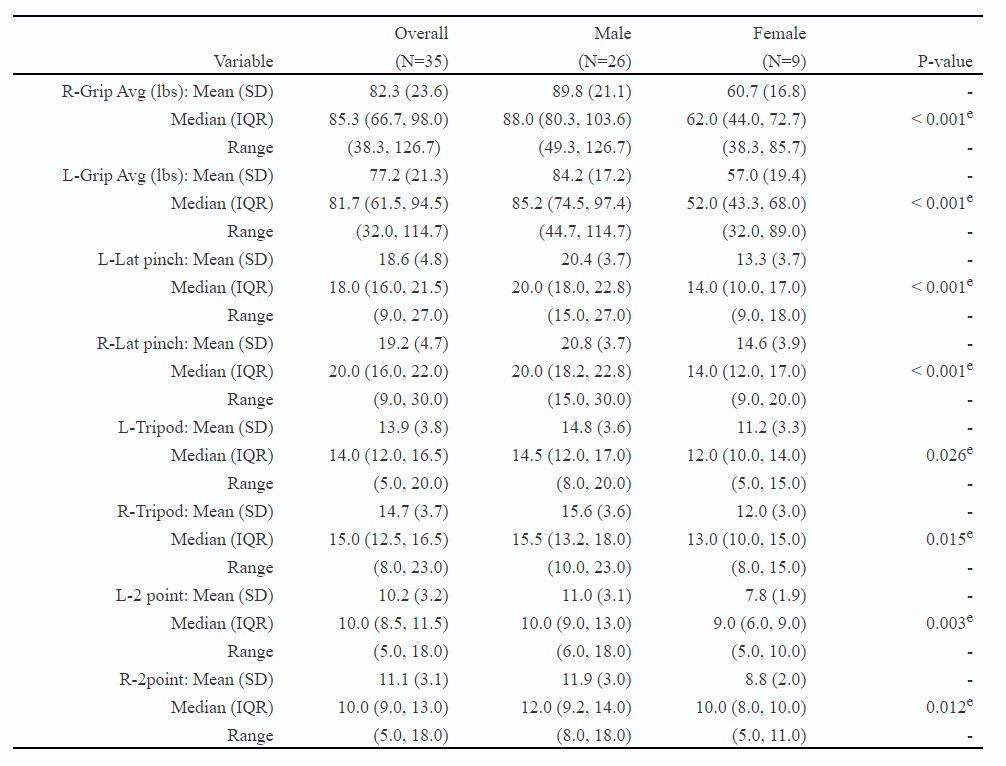Oral Paper Presentation
Annual Scientific Meeting
Session: Presidential Plenary Session 1
5 - Positive Provocative Testing and Symptom Evaluation for Objective Detection of Upper Extremity Repetitive Use Injuries Among Endoscopists
Monday, October 28, 2024
8:48 AM - 9:00 AM ET
Location: Terrace Ballroom

Daryl Ramai, MD, MPH, Msc
University of Utah Health
Salt Lake City, UT
Presenting Author(s)
Award: ACG Outstanding Research Award in the General Endoscopy Category (Trainee)
Daryl Ramai, MD, MPH, Msc1, Gregory Toy, MD2, Elizabeth Cardell, PhD2, Jamie Leatham, 2, Natalie Mudrow, MSc2, Kathryn Byrne, MD2, John Fang, MD2
1University of Utah Health, Salt Lake City, UT; 2University of Utah, Salt Lake City, UT
Introduction: The majority of endoscopists report suffering from musculoskeletal pain, yet a comprehensive and objective investigation into repetitive use symptoms or injuries has not been conducted. We aim to evaluate a cohort of endoscopists for upper extremity repetitive use injury using objective assessments.
Methods: Subjects were evaluated by Occupational Therapists consisting of strength testing and a series of provocative tests to identify clinical evidence of injury. We also employed a 43 author-developed questionnaire as well as the validated QuickDASH (Disability of Arm, Shoulder, Hand) questionnaire. Demographic factors, reported symptoms, and signs of injury were then analyzed. Lasso regression modelling was used to identify the risk factors that influenced outcomes provided by strength testing.
Results: Thirty-five endoscopists who performed endoscopy at the University of Utah were enrolled. Overall, 34.3% of participants reported experiencing pain, while 17.1% reported numbness. In the previous week, 48.5% had been bothered by pain, 11.4% felt tingling, 17.1% experienced interrupted sleep, and 17.1% reported limitations in work duties. Physical testing revealed that a significant number of endoscopists had below-normal strength in their right grip (48.6%) and left grip (42.9%). Additionally, 88.6% had below-normal pinch strengths for their age and gender. Furthermore, 71.4% of the group had at least one abnormal positive provocative test. Participants who reported numbness at night (p=0.015) and those in current pain (p < 0.001) reported higher DASH disability scores. Current pain was also associated with performing 20 or more procedures per week (p=.007). Moreover, those with a positive provocative test of the neck or elbow were likely to have below-normal pinch (p < .05) and grip strength (p < .05). Finally, it was found that performing ERCP 20-60% of the week was more likely to result in decreased bilateral pinch strength.
Discussion: Our study shows a high prevalence of reported ERI symptoms when an entire cohort of endoscopists were assessed. We found a high prevalence of repetitive use injury symptoms among endoscopists, corroborated by objective physical examination and testing. Further studies should expand this testing to larger groups of endoscopists in addition to other practice settings with the ultimate goal of developing awareness and interventions to prevent and manage endoscopy related injury.

Disclosures:
Daryl Ramai, MD, MPH, Msc1, Gregory Toy, MD2, Elizabeth Cardell, PhD2, Jamie Leatham, 2, Natalie Mudrow, MSc2, Kathryn Byrne, MD2, John Fang, MD2, 5, Positive Provocative Testing and Symptom Evaluation for Objective Detection of Upper Extremity Repetitive Use Injuries Among Endoscopists, ACG 2024 Annual Scientific Meeting Abstracts. Philadelphia, PA: American College of Gastroenterology.
Daryl Ramai, MD, MPH, Msc1, Gregory Toy, MD2, Elizabeth Cardell, PhD2, Jamie Leatham, 2, Natalie Mudrow, MSc2, Kathryn Byrne, MD2, John Fang, MD2
1University of Utah Health, Salt Lake City, UT; 2University of Utah, Salt Lake City, UT
Introduction: The majority of endoscopists report suffering from musculoskeletal pain, yet a comprehensive and objective investigation into repetitive use symptoms or injuries has not been conducted. We aim to evaluate a cohort of endoscopists for upper extremity repetitive use injury using objective assessments.
Methods: Subjects were evaluated by Occupational Therapists consisting of strength testing and a series of provocative tests to identify clinical evidence of injury. We also employed a 43 author-developed questionnaire as well as the validated QuickDASH (Disability of Arm, Shoulder, Hand) questionnaire. Demographic factors, reported symptoms, and signs of injury were then analyzed. Lasso regression modelling was used to identify the risk factors that influenced outcomes provided by strength testing.
Results: Thirty-five endoscopists who performed endoscopy at the University of Utah were enrolled. Overall, 34.3% of participants reported experiencing pain, while 17.1% reported numbness. In the previous week, 48.5% had been bothered by pain, 11.4% felt tingling, 17.1% experienced interrupted sleep, and 17.1% reported limitations in work duties. Physical testing revealed that a significant number of endoscopists had below-normal strength in their right grip (48.6%) and left grip (42.9%). Additionally, 88.6% had below-normal pinch strengths for their age and gender. Furthermore, 71.4% of the group had at least one abnormal positive provocative test. Participants who reported numbness at night (p=0.015) and those in current pain (p < 0.001) reported higher DASH disability scores. Current pain was also associated with performing 20 or more procedures per week (p=.007). Moreover, those with a positive provocative test of the neck or elbow were likely to have below-normal pinch (p < .05) and grip strength (p < .05). Finally, it was found that performing ERCP 20-60% of the week was more likely to result in decreased bilateral pinch strength.
Discussion: Our study shows a high prevalence of reported ERI symptoms when an entire cohort of endoscopists were assessed. We found a high prevalence of repetitive use injury symptoms among endoscopists, corroborated by objective physical examination and testing. Further studies should expand this testing to larger groups of endoscopists in addition to other practice settings with the ultimate goal of developing awareness and interventions to prevent and manage endoscopy related injury.

Table: Grip strength testing by gender
Disclosures:
Daryl Ramai indicated no relevant financial relationships.
Gregory Toy indicated no relevant financial relationships.
Elizabeth Cardell indicated no relevant financial relationships.
Jamie Leatham indicated no relevant financial relationships.
Natalie Mudrow indicated no relevant financial relationships.
Kathryn Byrne indicated no relevant financial relationships.
John Fang indicated no relevant financial relationships.
Daryl Ramai, MD, MPH, Msc1, Gregory Toy, MD2, Elizabeth Cardell, PhD2, Jamie Leatham, 2, Natalie Mudrow, MSc2, Kathryn Byrne, MD2, John Fang, MD2, 5, Positive Provocative Testing and Symptom Evaluation for Objective Detection of Upper Extremity Repetitive Use Injuries Among Endoscopists, ACG 2024 Annual Scientific Meeting Abstracts. Philadelphia, PA: American College of Gastroenterology.



